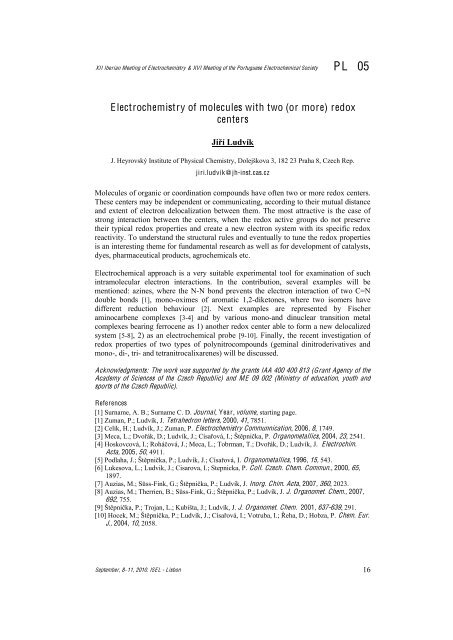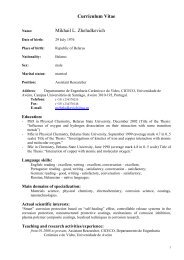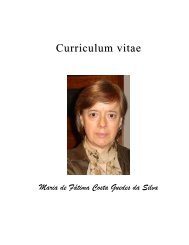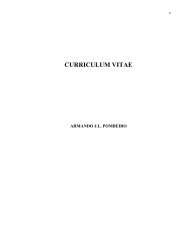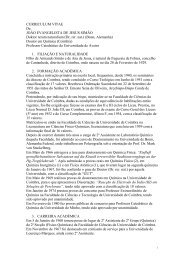XII Iberian Meeting of Electrochemistry XVI Meeting of the ...
XII Iberian Meeting of Electrochemistry XVI Meeting of the ...
XII Iberian Meeting of Electrochemistry XVI Meeting of the ...
You also want an ePaper? Increase the reach of your titles
YUMPU automatically turns print PDFs into web optimized ePapers that Google loves.
<strong>XII</strong> <strong>Iberian</strong> <strong>Meeting</strong> <strong>of</strong> <strong>Electrochemistry</strong> & <strong>XVI</strong> <strong>Meeting</strong> <strong>of</strong> <strong>the</strong> Portuguese Electrochemical Society PL 05<br />
<strong>Electrochemistry</strong> <strong>of</strong> molecules with two (or more) redox<br />
centers<br />
<br />
J. Heyrovský Institute <strong>of</strong> Physical ChemistryCzech Rep.<br />
jiri.ludvik@ jh-inst.cas.cz<br />
Molecules <strong>of</strong> organic or coordination compounds have <strong>of</strong>ten two or more redox centers.<br />
These centers may be independent or communicating, according to <strong>the</strong>ir mutual distance<br />
and extent <strong>of</strong> electron delocalization between <strong>the</strong>m. The most attractive is <strong>the</strong> case <strong>of</strong><br />
strong interaction between <strong>the</strong> centers, when <strong>the</strong> redox active groups do not preserve<br />
<strong>the</strong>ir typical redox properties and create a new electron system with its specific redox<br />
reactivity. To understand <strong>the</strong> structural rules and eventually to tune <strong>the</strong> redox properties<br />
is an interesting <strong>the</strong>me for fundamental research as well as for development <strong>of</strong> catalysts,<br />
dyes, pharmaceutical products, agrochemicals etc.<br />
Electrochemical approach is a very suitable experimental tool for examination <strong>of</strong> such<br />
intramolecular electron interactions. In <strong>the</strong> contribution, several examples will be<br />
mentioned: azines, where <strong>the</strong> N-N bond prevents <strong>the</strong> electron interaction <strong>of</strong> two C=N<br />
double bonds [1], mono-oximes <strong>of</strong> aromatic 1,2-diketones, where two isomers have<br />
different reduction behaviour [2]. Next examples are represented by Fischer<br />
aminocarbene complexes [3-4] and by various mono-and dinuclear transition metal<br />
complexes bearing ferrocene as 1) ano<strong>the</strong>r redox center able to form a new delocalized<br />
system [5-8], 2) as an electrochemical probe [9-10]. Finally, <strong>the</strong> recent investigation <strong>of</strong><br />
redox properties <strong>of</strong> two types <strong>of</strong> polynitrocompounds (geminal dinitroderivatives and<br />
mono-, di-, tri- and tetranitrocalixarenes) will be discussed.<br />
Acknowledgments: The work was supported by <strong>the</strong> grants IAA 400 400 813 (Grant Agency <strong>of</strong> <strong>the</strong><br />
Academy <strong>of</strong> Sciences <strong>of</strong> <strong>the</strong> Czech Republic) and ME 09 002 (Ministry <strong>of</strong> education, youth and<br />
sports <strong>of</strong> <strong>the</strong> Czech Republic).<br />
References<br />
[1] Surname, A. B.; Surname C. D. Journal, Year, volume, starting page.<br />
[1] Zuman, P.; Ludvík, J. Tetrahedron letters, 2000, 41, 7851.<br />
[2] Celik, H.; Ludvík, J.; Zuman, P. <strong>Electrochemistry</strong> Communnication, 2006, 8, 1749.<br />
[3] Meca, L.; D.; Ludvík, J.; I.; , P. Organometallics, 2004, 23, 2541.<br />
[4] Hoskovcová, I.; J.; Meca, L.; Tobrman, T.; D.; Ludvík, J. Electrochim.<br />
Acta, 2005, 50, 4911.<br />
[5] Organometallics, 1996, 15, 543.<br />
[6] Lukesova, L.; Ludvik, J.; Cisarova, I.; Stepnicka, P. Coll. Czech. Chem. Commun., 2000, 65,<br />
1897.<br />
[7] Auzias, M.; Süss-J. Inorg. Chim. Acta, 2007, 360, 2023.<br />
[8] Auzias, M.; Therrien, B.; Süss-J. Organomet. Chem., 2007,<br />
692, 755.<br />
J. Organomet. Chem. 2001, 637-639, 291.<br />
Chem. Eur.<br />
J., 2004, 10, 2058.<br />
September, 811, 2010. ISEL - Lisbon 16


